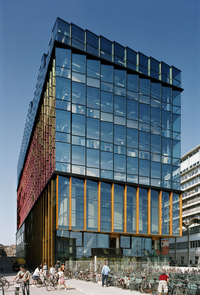History
The Conservatorium van Amsterdam was founded in 1884, then called the Amsterdamsch Conservatorium, almost at the same time as the Royal Concertgebouw Orchestra (RCO). At the time, the RCO had its own orchestral class, which was rapidly subsumed into the conservatory. The links between the two institutions have been very close ever since. Many of the orchestra’s players also taught at the conservatory and many former students went on to occupy important positions within the RCO. The result was a hitherto unknown degree of professionalism within the Dutch musical world in the late 19th and early 20th centuries. Within ten years, Amsterdam gained a preeminent position on the world stage, a position that it has retained to this day. The RCO and the Conservatorium van Amsterdam have in the past stood for and still represent the very best in international professional performance practice.
In 1976, the Amsterdamsch Conservatorium, the Conservatorium van de Vereniging Muzieklyceum and the Haarlem Muzieklyceum merged to form the Sweelinck Conservatorium Amsterdam. The outstanding international reputation in the field of classical music was expanded in 1994, by a further merger with the Hilversum Conservatorium, into the field of jazz. Under its new title of ‘Conservatorium van Amsterdam’, the largest conservatory in the Netherlands now took shape, with all genres under its roof: Early Music, Classical Music, Orchestral Conducting, Opera, Jazz, Music in Education and, since 2003, Pop Music as well.
As a result of all these developments, the Conservatorium van Amsterdam outgrew its old home on the Van Baerlestraat, resulting in the decision to embark on new construction. The new building at the Oosterdokskade, within walking distance of the Muziekgebouw aan ’t IJ, the Bimhuis, the Amsterdam Public Library and the Central Station, was first occupied in 2008. The building transformed dreams and desires into reality: four concert halls, well-equipped teaching rooms, state of the art recording studios that are generous enough for large ensembles, digital connections to all of the concert halls, a large number of study rooms, a very comprehensive library, and not least a foyer annex canteen where staff, students and visitors all feel welcome. All of these facilities place the Conservatorium van Amsterdam at the heart of contemporary music practice.
A survey of the facts
● 1884: the Amsterdamsch Conservatorium is founded
● 1888: the Concertgebouw building is completed
● 1920: establishment of a conservatory by a society called 'Muzieklyceum'
● 1931: the Bachzaal is completed
● 1976: Amsterdamsch Conservatorium, Muzieklyceum and Haarlems Muzieklyceum merge to form the Sweelinck Conservatorium
● 1985: the Sweelinck Conservatorium moves to the former savings bank building in the Van Baerlestraat
● 1994: Sweelinck Conservatorium and Hilversums Conservatorium merge to form the Conservatorium van Amsterdam
● 1998: the merger is finally completed, with all training programmes taking place in the Van Baerlestraat and the Nieuwe Vaart
● April 2008: the conservatory moves to its new building at Oosterdokseiland in Amsterdam



